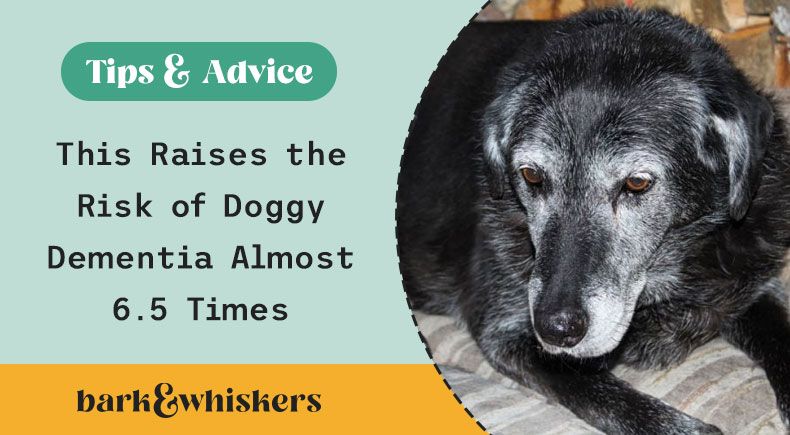This Raises the Risk of Doggy Dementia Almost 6.5 Times
Like with humans, cognitive function declines with age in dogs, and its signs in older dogs include reduced spatial awareness, sleep disruption, a change in social interactions and memory deficits. This new study reveals a powerful intervention that could dramatically lower your dog's risk.

STORY AT-A-GLANCE
- A newly published study reveals that Canine Cognitive Decline (CCD), aka doggy dementia, may be a much more significant problem for inactive vs. very active dogs
- The study suggests that the risk of developing CCD is almost 6.5 times greater in inactive dogs, which further illustrates how important it is for canine companions to remain active throughout their lives
- Frequent walks are an excellent way to keep your dog fit and fully mobile; done right, they can also keep her mind stimulated and her social skills sharp; regular hydrotherapy sessions are another great tool, especially for older dogs
- Exercises specifically designed to maintain your dog’s strength, flexibility and balance are essential, along with gentle stretching; also, don’t overlook the benefits of massage to enhance your dog’s comfort and mobility
In both humans and dogs, cognitive function declines with age. Canine Cognitive Dysfunction (CCD), aka doggy dementia, a neurodegenerative condition, is often characterized by memory deficits, loss of spatial awareness, altered social interactions, and sleep disruption. Estimates of CCD rates range from 28% in 11 to 12-year-old dogs up to 68% in 15 to 16-year-old dogs.
Generally speaking (because there are always exceptions to every rule concerning our canine companions), once a dog reaches age 10, each year lived beyond that increases the relative risk for CCD by more than 50%. Further, according to a new study, the risk of developing CCD is almost 6.5 times greater in inactive dogs vs. very active dogs.
Do Active Dogs Experience Less Cognitive Decline?
For the study, a team of University of Washington epidemiologists and members of the Dog Aging Project Consortium evaluated the prevalence of CCD in a large population of dogs (over 15,000) participating in the Dog Aging Project.
Toward the end of 2019, the dogs’ owners completed two surveys: the Health and Life Experience survey about health status and physical activity, as well as the Canine Social and Learned Behavior survey that tests for signs of CCD (e.g., failing to recognize familiar people). The dogs’ lifespans were categorized as follows:
- 19.5% were in the last quartile of their life
- 24.4% were in the third quartile
- 27% were in the second quartile
- 29.1% were in the first quartile
Of these dogs, 1.4% were classified as having CCD. According to the study results, when looking at age alone, for dogs over age 10, the likelihood of being diagnosed with CCD increased by 68% for each additional year of age.
When other factors were considered, such as breed, sterilization status, health problems, and activity levels, the odds of developing CCD dropped to 52% for each additional year of life. When controlling for age, breed type, activity level, and other comorbidities, dogs with a history of neurological, eye, or ear disorders had higher odds of CCD.
Interestingly, for dogs of the same age, breed, health, and sterilization status, the odds of CCD were 6.47 times higher in less active or inactive dogs (as reported by their owners) compared to dogs reported as very active.
However, the study co-authors caution that their results don’t show a clearcut cause-and-effect relationship between inactivity and CCD, and that cognitive decline may in fact lead to reduced activity. They conclude that further research is needed to better understand CCD.
Defying Doggy Dementia Through Movement
Not that we needed one, but preventing cognitive dysfunction is certainly another excellent reason to ensure your canine companion gets all the physical activity she needs.
Dogs are designed for movement no matter their age. An active dog is a happy dog (and a tired dog is a better-behaved dog). One of the most impactful things you can do for your furry best friend is provide her with plenty of opportunities to stay physically active throughout her life.
It’s important to realize that movement is just as important for older dogs as it is for their younger counterparts. Regular exercise keeps your pet’s joints flexible and her muscles strong. It burns calories and provides mental stimulation. Daily physical activity slows the aging process and enhances quality of life. Dogs who remain active at every age tend to live longer, higher quality lives than pets who aren’t given daily opportunities for physical movement.
The following are five ways you can help keep your dog active, mobile, comfortable, and mentally sharp to ensure her golden years are happy and healthy.
- Walking — Walking is great lifelong exercise for both you and your older canine companion. Most dogs love to get out and about, and while seniors might not be able to do much power walking, several short walks each day and two or three 30 to 60 minute weekly sniffaris will go a long way to keep your aging dog's body and mind in healthy and fit.
You'll want to avoid longer walks when it's very cold or hot outside. In the warmer months, keep an eye on your dog for signs he's tiring out or overheating. Walking up gradual (not steep) hills will help strengthen his hips; taking a zigzag pattern on steep downhill stretches will prevent stress to his front legs.
Training walks with your older dog can help keep his mind sharp. These walks can be about refreshing his leash manners, teaching new obedience commands, or for ongoing socialization. Also consider change-of-scenery walks. Drive your dog a few blocks away or to a neighborhood park for a stroll. These outings will serve up new things for him to see, smell and experience.
If your dog is comfortable around other dogs, consider meeting up with neighbors or friends with dogs for group walks. Everyone on two legs and four gets to socialize and exercise simultaneously, and dog parents can also be valuable resources for one another. - Swimming — Since natural bodies of water can hold unpleasant and even toxic surprises for dogs, and the water in backyard swimming pools tends to be cold and not recommended for pets with arthritis, the ideal situation if you can arrange it is to bring your dog to a water therapy (hydrotherapy) center.
The water is warm in hydrotherapy tanks and pools, which is soothing to aging and sore joints and muscles. Hydrotherapy is a favorite of mine for many reasons:- Movement in water provides gentle resistance to help strengthen muscles
- The water's buoyancy helps support the weight of animals who aren't as strong as they used to be
- The lack of gravity relieves stress on degenerating joints
- The pressure of water on the body improves circulation and helps decrease swelling
- Exercises to Maintain Strength, Flexibility and Balance — In older dogs, the aging process can lead to a vicious cycle of decreased muscle strength, increased muscle stiffness and an overall decrease in balance. The inactivity resulting from this dynamic often leads to weight gain, which adds stress on joints that are no longer well supported by adequate muscle mass.
One way to help avoid this downward spiral is to ensure your dog engages in exercises specifically designed to maintain strength, flexibility and balance. There are three categories of these exercises:- Movements that target the big, body-supporting muscles like the quadriceps, hamstrings and gluteals
- Movements that maintain balance and fluid movement
- Passive range-of-motion (PROM) exercises for joint health
- Stretching — Stretching helps your dog's body relax while promoting flexibility. You can enhance her stretching routine with some gentle hands-on movements of her front and rear legs, shoulders, spine, elbows, knees, wrists, ankles, chest and shoulders.
Stretches are best done after exercise. There are three areas of your dog's body for which stretching is especially beneficial — the hips, shoulders and back. The stretches shown and described here, done slowly and gently, are well-tolerated by most dogs.
Instructions for most of these stretches have your dog standing, but you can also do them with her lying on her side, or in the case of the chest stretch, on her back. Some dogs are very uncomfortable in this position, so if yours is, don't force the issue.
Needless to say, if she shows any sign of pain during stretching, discontinue the movement and have her seen by your veterinarian as soon as possible. - Massage — Canine therapeutic massage offers benefits such as increased muscle flexibility, reduced pain in stiff joints and muscles, stress relief, and improved circulation. Massage can even help alleviate problem behaviors such as sensitivity to touch, fear-biting, food or dog-related aggression, and separation anxiety.
Massage for pets, especially older dogs, involves slow, gentle strokes and stretches, combined with light, rhythmic tapping. Benefits of regular massage for your pet include:- Helps keep your senior dog's muscles toned and reduces the slackening that comes with aging
- Massaged muscles are looser, which makes it much easier for your dog to move around comfortably
- Massages improve circulation and encourage lymphatic drainage
- Regular massage also eases the stiffness of arthritis, which can help your pet maintain his normal gait and active lifestyle
- Massage loosens the muscles around joints, which also helps promote ease of movement
You may also like the idea of massaging your pet yourself, and this can have additional calming and bonding benefits. If you'd like to go this route, consider taking a workshop or continuing education course to learn basic hands-on massage skills — programs are offered at all levels, for pet parents simply looking to massage their own pets to those interested in becoming licensed animal massage practitioners.
Whichever avenue you choose, offering the benefits of therapeutic massage to your dog is one of the greatest gifts you can give him to support his happiness and quality of life.










